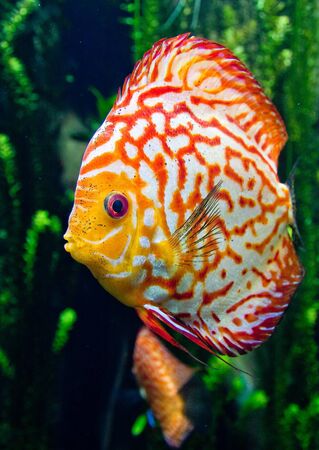Introduction to Aquarium Temperature Control
Maintaining the correct water temperature is a crucial aspect of ensuring a healthy and thriving environment for your fish, especially in British home aquariums. Fish are ectothermic creatures, meaning their body temperature is regulated by the surrounding water. Fluctuations or extremes in temperature can cause significant stress, weaken immune responses, and even lead to illness or death. In the UK, where seasonal changes bring about chilly winters and occasionally warm summers, controlling aquarium temperature becomes particularly important. British homes often experience fluctuating indoor temperatures due to central heating systems or draughts, which can impact tank stability. Therefore, understanding how to effectively manage heaters and temperature control devices tailored to local climate conditions is essential for every UK aquarium enthusiast who wishes to promote optimal fish health and well-being.
2. Choosing the Right Aquarium Heater for UK Homes
When setting up an aquarium in a British home, selecting the right type of heater is crucial to maintain a stable environment for your aquatic life, especially given the UKs variable climate and central heating patterns. Several types of aquarium heaters are available, each with distinct advantages and considerations that should be matched to your homes unique conditions.
Common Types of Aquarium Heaters
| Heater Type | Description | Best Suited For | Considerations in UK Homes |
|---|---|---|---|
| Submersible Heaters | Fully submerges within the tank and is often adjustable. | Most standard aquariums; versatile and easy to install. | Ideal for tanks placed away from radiators or draughty windows. Offers uniform heat distribution. |
| Immersible Heaters | Sits partly above water; heating element is in water, controls stay dry. | Smaller tanks or temporary setups. | Less suitable for covered tanks or environments with fluctuating room temperatures. |
| Heating Mats/Pads | Placed under the tank to gently warm the substrate. | Tropical species needing bottom warmth; planted tanks. | Might not suffice as the sole heat source in colder British homes. Often used alongside other heaters. |
Selecting the Most Suitable Heater for Your Home
The British home environment presents unique challenges, such as central heating cycles, older properties with poor insulation, and seasonal temperature swings. Consider the following when choosing your heater:
- Room Location: If your aquarium is near a window or external wall, opt for a submersible heater with a reliable thermostat to counteract cold drafts common in UK winters.
- Aquarium Size: Larger tanks benefit from dual heaters or higher wattage units, while nano tanks may only require a small submersible or immersible heater.
- Aquatic Species: Tropical fish require precise temperature control (usually 24–27°C), making adjustable submersible heaters ideal. Coldwater species may need less frequent heating but can still benefit from stabilisation during winter.
- Energy Efficiency: Modern thermostatic heaters help regulate power usage—an important consideration for eco-conscious British households aiming to minimise energy bills.
Practical Tips for Installation and Use
- Always use a separate aquarium thermometer to cross-check heater accuracy, especially during seasonal transitions.
- If you live in an older house with chilly rooms, consider insulating the back of your tank or using background panels to retain warmth more efficiently.
- Select models that are easy to adjust and monitor—a useful feature when British weather is unpredictable.
Selecting the right aquarium heater tailored to your specific UK home conditions will ensure a healthy environment for your fish all year round, promoting their wellbeing and reducing stress-related health issues.
![]()
3. Setting and Monitoring Water Temperatures
Maintaining the correct water temperature is crucial for a healthy aquarium environment, especially in the UK where seasonal changes can affect indoor temperatures significantly. Below are some practical tips and guidance to help British aquarists keep their tanks stable throughout the year.
Setting Thermostat Levels
Start by checking the ideal temperature range for your specific fish species—tropical fish usually thrive between 24°C and 27°C, while coldwater species prefer cooler conditions. Set your aquarium heater’s thermostat accordingly, making small adjustments as needed to suit your tank inhabitants. For British homes that may get chilly in winter, it’s wise to set the heater slightly above the lower end of the recommended range to prevent overnight dips.
Using Reliable Thermometers
Invest in a quality aquarium thermometer—either digital or traditional glass stick-on models—and place it away from the heater to get an accurate overall reading. Check the temperature at least once daily, particularly during colder months or heatwaves, as central heating or sudden weather changes can influence tank conditions. Many UK hobbyists find digital thermometers with alarms helpful for alerting them to rapid fluctuations.
Recognising Fluctuations Relevant to UK Seasons
British weather can be unpredictable, with warm summers and cold winters placing extra demands on aquarium temperature control. Sudden drops in room temperature during a cold snap may overwork heaters, while unseasonably warm days can risk overheating. Be vigilant for signs such as sluggish fish or abnormal swimming, which may indicate thermal stress. Consider using an aquarium controller to automate heating and cooling if your home is prone to wide seasonal swings.
Top Tips for British Aquariums
– Insulate your tank with a background or polystyrene mat in winter
– Avoid placing tanks near radiators or draughty windows
– Double-check settings after power cuts or daylight savings time changes
– Keep a log of daily readings to spot trends before they become issues
By consistently monitoring and adjusting your aquarium’s temperature, you’ll provide a safe and comfortable habitat for your aquatic pets, no matter what the British weather brings.
4. Safety Considerations and Energy Efficiency
Ensuring the safety and efficiency of aquarium heaters is paramount for every British home aquarist, particularly as energy prices continue to rise and electrical safety standards remain stringent across the UK. Below, we provide essential advice on heater safety, preventing electrical hazards, and choosing energy-efficient options.
Advice on Heater Safety
Always purchase heaters that comply with UK safety regulations (look for the CE marking and adherence to BS EN standards). Position your heater securely within the tank, away from direct contact with decorations or gravel to avoid damage. Regularly inspect the glass casing for cracks and replace any faulty equipment promptly. Use a reliable thermometer to monitor water temperature and prevent overheating.
Preventing Electrical Hazards
- Install a Residual Current Device (RCD) on your aquariums power supply to minimise the risk of electric shock.
- Ensure all plugs and sockets are dry before handling; never touch electrical equipment with wet hands.
- Position drip loops in power cables to prevent water from running down into sockets.
- If possible, use a heater guard to protect both fish and heater from accidental contact.
Energy-Efficient Heater Options
With the cost of electricity steadily increasing in the UK, opting for an energy-efficient heater can reduce ongoing expenses without compromising your fishs wellbeing. Consider using modern electronic heaters with programmable thermostats, which maintain stable temperatures more effectively and only operate when necessary.
| Heater Type | Average Wattage | Energy Efficiency Features | Estimated Annual Cost* |
|---|---|---|---|
| Traditional Glass Heater | 100-300W | Manual Thermostat | £25-70 |
| Electronic Heater with Digital Thermostat | 50-200W | Automatic Shut-off, Programmable Settings | £15-45 |
| Titanium Heater with External Controller | 75-250W | Precise Temperature Control, Faster Response Time | £20-55 |
*Estimates based on average daily use and current UK electricity prices.
Sustainability Tips for UK Aquarists
- Match heater size to tank volume—oversized heaters waste energy.
- Keep tanks covered to retain heat and reduce heater workload.
- Place tanks away from draughts or radiators to maintain stable ambient temperatures.
- Consider LED lighting as it generates less heat than traditional bulbs, reducing overall temperature fluctuations.
A Final Word on Safety and Efficiency
Selecting a high-quality heater, following proper installation protocols, and regularly maintaining your equipment will keep both your aquatic life and your household safe while helping manage electricity costs—a win-win for British aquarists committed to best practice in pet care and sustainability.
5. Common Problems and Troubleshooting in British Aquariums
Identifying Heater Failure
Heater failure is a frequent concern for aquarium owners across the UK, especially during colder months. Signs of malfunction include consistently low water temperatures, condensation inside the heater casing, or visible damage to the heater element. To check for heater failure, use an accurate thermometer placed at both ends of the tank and compare readings. If the temperature remains below your desired range despite adjustments, it’s time to replace or repair the heater. Always unplug electrical equipment before inspecting or replacing it.
Troubles with Erratic Thermostat Behaviour
Erratic thermostat behaviour can cause sudden temperature fluctuations, which may stress or harm your fish. You might notice the water becoming too warm or cooling off unexpectedly. To troubleshoot, monitor temperature changes over several days using a reliable digital thermometer. If you find significant inconsistencies, consider recalibrating the thermostat if your model allows it. Otherwise, replacement is usually necessary. For added peace of mind, many British aquarists opt for heaters with built-in thermal cut-off switches or use separate thermostatic controllers as backup.
Dealing with Cold Spots
Cold spots are common in larger or irregularly shaped tanks where water circulation is insufficient. Fish clustering in one area or slow growth of tropical plants can indicate uneven heating. In the typical British home—where radiators and draughts from windows or doors can affect room temperature—these issues are more pronounced. Address cold spots by adjusting the position of your heater near a filter outlet or installing an additional small heater at the opposite end of the aquarium. Using an aquarium-safe circulation pump helps distribute heat evenly throughout the tank.
Practical Solutions for British Homes
Given the fluctuating climate and older housing stock in many parts of the UK, maintaining stable tank temperatures requires vigilance. Regularly check all equipment for signs of wear and ensure power sockets are dry and protected from splashes. During winter, avoid placing aquariums close to external walls or draughty windows; insulated backgrounds or covers can help retain warmth. Investing in a power surge protector is also wise, as power cuts and surges are not uncommon in some areas. By staying proactive and addressing minor issues promptly, you can keep your home aquarium healthy and resilient year-round.
6. Preventive Maintenance and Seasonal Adjustments
Maintaining stable temperatures in British home aquariums is not just about installing a reliable heater; it’s also about regular preventive care and adjusting your setup as the seasons change. The UK’s climate brings distinct seasonal fluctuations, with chilly winters and milder summers, so aquarium owners must proactively manage their heating systems to ensure optimal aquatic health all year round.
Routine Heater Checks and Cleaning
Preventive maintenance starts with inspecting your heater at least once a month. Check for mineral build-up, corrosion, or signs of wear on both the heater and thermostat. Clean any debris from the heater casing and ensure it is fully submerged according to the manufacturer’s guidelines. Testing your thermometer’s accuracy with a second device can prevent undetected temperature drift, which is common in older equipment.
Winter Worries: Boosting Your Setup
British winters can cause room temperatures to drop significantly, putting extra demand on your aquarium heater. In colder months, consider investing in a backup heater or an inline heating system for larger tanks. Insulating the aquarium glass with foam sheets or placing the tank away from draughty windows can help retain warmth. It’s also wise to check your power supply and have a battery-powered air pump on hand in case of winter outages.
Summer Strategies: Avoiding Overheating
While UK summers are typically mild, heatwaves have become more frequent. In warmer months, position your aquarium away from direct sunlight and avoid rooms that overheat easily. If you notice water temperatures rising above recommended levels for your fish species, use a fan to promote evaporation or partially open the lid for better airflow. Some aquarists use aquarium chillers or frozen water bottles as short-term solutions during extreme heat spells.
Consistent Aquatic Health Year-Round
By combining regular equipment checks with seasonal adjustments tailored to the British climate, you create a stable environment where aquatic life can thrive. Consistency is key—avoid abrupt temperature changes by making gradual adjustments and monitoring water conditions closely after any modification to your heating setup. This proactive approach not only supports fish health but also reduces the risk of disease outbreaks associated with temperature stress.
Remember, preventive care is always preferable to emergency fixes. With careful attention throughout the year, British aquarists can enjoy healthy, vibrant tanks whatever the weather outside.


